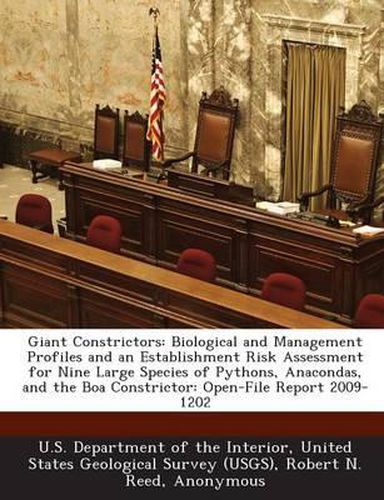Readings Newsletter
Become a Readings Member to make your shopping experience even easier.
Sign in or sign up for free!
You’re not far away from qualifying for FREE standard shipping within Australia
You’ve qualified for FREE standard shipping within Australia
The cart is loading…






Giant Constrictors: Biological and Management Profiles and an Establishment Risk Assessment for Nine Large Species of Pythons, Anacondas, and the Boa Constrictor, estimates the ecological risks associated with colonization of the United States by nine large constrictors. The nine include the world’s four largest snake species (Green Anaconda, Eunectes murinus; Indian or Burmese Python, Python molurus; Northern African Python, Python sebae; and Reticulated Python, Broghammerus reticulatus), the Boa Constrictor (Boa constrictor), and four species that are ecologically or visually similar to one of the above (Southern African Python, Python natalensis; Yellow Anaconda, Eunectes notaeus; DeSchauensee’s Anaconda, Eunectes deschauenseei; and Beni Anaconda, Eunectes beniensis). At present, the only probable pathway by which these species would become established in the United States is the pet trade. Although importation for the pet trade involves some risk that these animals could become established as exotic or invasive species, it does not guarantee such establishment. Federal regulators have the task of appraising the importation risks and balancing those risks against economic, social, and ecological benefits associated with the importation. The risk assessment quantifies only the ecological risks, recognizing that ecosystem processes are complex and only poorly understood. The risk assessment enumerates the types of economic impacts that may be experienced, but leaves quantification of economic costs to subsequent studies. Primary factors considered in judging the risk of establishment were: (1) history of establishment in other countries, (2) number of each species in commerce, (3) suitability of U.S. climates for each species, and (4) natural history traits, such as reproductive rate and dispersal ability, that influence the probability of establishment, spread, and impact. In addition, the risk assessment reviews all management tools for control of invasive giant
$9.00 standard shipping within Australia
FREE standard shipping within Australia for orders over $100.00
Express & International shipping calculated at checkout
Giant Constrictors: Biological and Management Profiles and an Establishment Risk Assessment for Nine Large Species of Pythons, Anacondas, and the Boa Constrictor, estimates the ecological risks associated with colonization of the United States by nine large constrictors. The nine include the world’s four largest snake species (Green Anaconda, Eunectes murinus; Indian or Burmese Python, Python molurus; Northern African Python, Python sebae; and Reticulated Python, Broghammerus reticulatus), the Boa Constrictor (Boa constrictor), and four species that are ecologically or visually similar to one of the above (Southern African Python, Python natalensis; Yellow Anaconda, Eunectes notaeus; DeSchauensee’s Anaconda, Eunectes deschauenseei; and Beni Anaconda, Eunectes beniensis). At present, the only probable pathway by which these species would become established in the United States is the pet trade. Although importation for the pet trade involves some risk that these animals could become established as exotic or invasive species, it does not guarantee such establishment. Federal regulators have the task of appraising the importation risks and balancing those risks against economic, social, and ecological benefits associated with the importation. The risk assessment quantifies only the ecological risks, recognizing that ecosystem processes are complex and only poorly understood. The risk assessment enumerates the types of economic impacts that may be experienced, but leaves quantification of economic costs to subsequent studies. Primary factors considered in judging the risk of establishment were: (1) history of establishment in other countries, (2) number of each species in commerce, (3) suitability of U.S. climates for each species, and (4) natural history traits, such as reproductive rate and dispersal ability, that influence the probability of establishment, spread, and impact. In addition, the risk assessment reviews all management tools for control of invasive giant